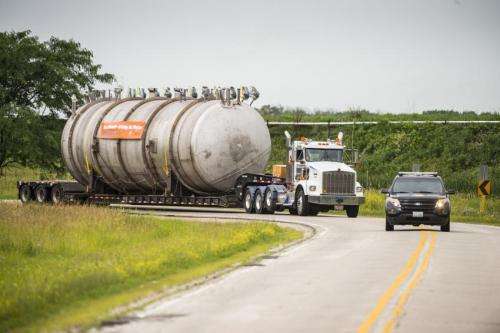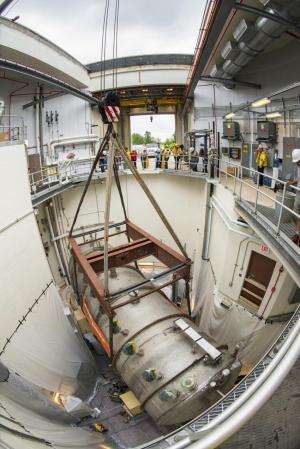Massive 30-ton MicroBooNE particle detector moved into place, will see neutrinos this year

(Phys.org) —On Monday, June 23, the next phase of neutrino physics at Fermilab fell (gently) into place. The MicroBooNE detector – a 30-ton, 40-foot-long cylindrical metal tank designed to detect ghostly particles called neutrinos – was carefully transported by truck across the U.S. Department of Energy's Fermilab site, from the warehouse building it was constructed in to the experimental hall three miles away.
The massive detector was then hoisted up with a crane, lowered through the open roof of the building and placed into its permanent home, directly in the path of Fermilab's beam of neutrinos. There it will become the centerpiece of the MicroBooNE experiment, which will study those elusive particles to crack several big mysteries of the universe.
The MicroBooNE detector has been under construction for nearly two years. The tank contains a 32-foot-long "time projection chamber," the largest ever built in the United States, equipped with 8,256 delicate gilded wires, which took the MicroBooNE team two months to attach by hand. This machine will allow scientists to further study the properties of neutrinos, particles that may hold the key to understanding many unexplained mysteries of the universe.
"This is a huge day for the MicroBooNE experiment," said Fermilab's Regina Rameika, project manager for the MicroBooNE experiment. "We've worked hard to create the best scientific instrument that we can. To see it moved into place was a thrill for the entire team."
The MicroBooNE detector will now be filled with 170 tons of liquid argon, a heavy liquid that will release charged particles when neutrinos interact with it. The detector's three layers of wires will then capture pictures of these interactions at different points in time and send that information to the experiment's computers.

Using one of the most sophisticated processing programs ever designed for a neutrino experiment, those computers will sift through the thousands of interactions that will occur every day and create stunning 3-D images of the most interesting ones. The MicroBooNE team will use that data to learn more about how neutrinos change from one type (or "flavor") to another, and narrow the search for a hypothesized (but as of yet, never observed) fourth type of neutrino.
"The scientific potential of MicroBooNE is really exciting," said Yale University's Bonnie Fleming, co-spokesperson for the MicroBooNE experiment. "After a long time spent designing and building the detector, we are thrilled to start taking data later this year."
MicroBooNE is a cornerstone of Fermilab's short-baseline neutrino program , which studies neutrinos traveling over shorter distances. (MINOS and NOvA, which send neutrinos through the Earth to Minnesota, are examples of long-baseline experiments.) In its recent report, the Particle Physics Project Prioritization Panel (P5) expressed strong support for the short-baseline neutrino program at Fermilab.
The P5 panel was comprised of members of the high-energy physics community. Their report was commissioned by the High Energy Physics Advisory Panel, which advises both the Department of Energy and the National Science Foundation on funding priorities.
The detector technology used in designing and building MicroBooNE will serve as a prototype for a much larger long-baseline neutrino facility planned for the United States, to be hosted at Fermilab. The P5 report also strongly supports this larger experiment, which will be designed and funded through a global collaboration.
To read the P5 report, visit this link: usparticlephysics.org/p5 .
Provided by Fermi National Accelerator Laboratory





















